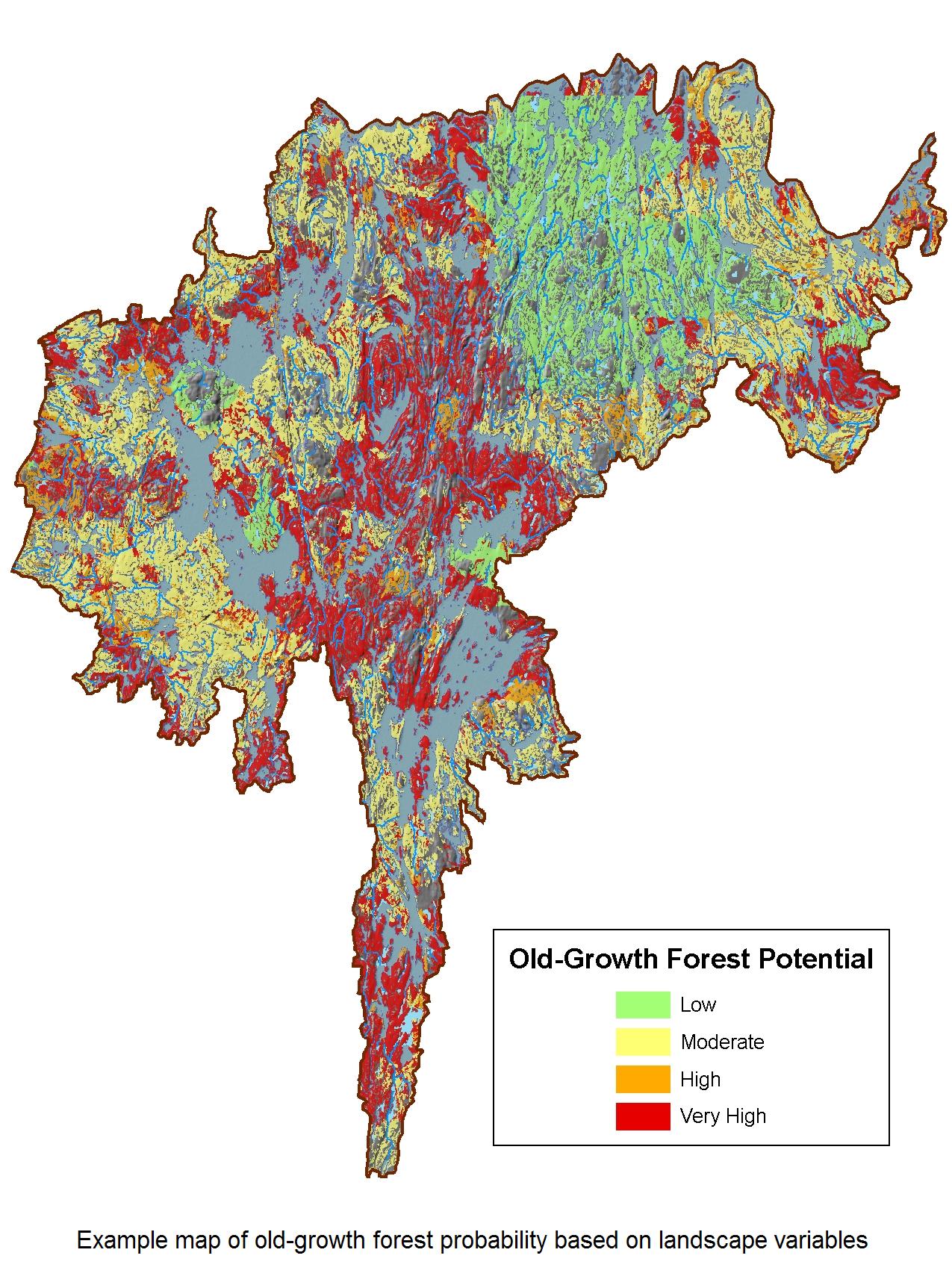 In contrast to the maximum sustained yield paradigm, where a common target of a forest manager was to liquidate slow-growing
old-growth forest, ecosystem-based management recognizes that retaining a variety of age-classes on a forest landscape is an
important aspect of maintaining biodiversity (Kimmins 2003). Due in part to relatively short fire cycles in the boreal
forest and the tendency for liquidation by forest management, retaining overmature age-classes on a managed forest landbase
often require specific polices such as old-growth retention requirements.
In contrast to the maximum sustained yield paradigm, where a common target of a forest manager was to liquidate slow-growing
old-growth forest, ecosystem-based management recognizes that retaining a variety of age-classes on a forest landscape is an
important aspect of maintaining biodiversity (Kimmins 2003). Due in part to relatively short fire cycles in the boreal
forest and the tendency for liquidation by forest management, retaining overmature age-classes on a managed forest landbase
often require specific polices such as old-growth retention requirements.
Old-growth retention requirements are increasingly being required of Forest Management Agreement (FMA) holders and are often being factored into Annual Allowable Cut calculations. For example, it is not uncommon for an FMA holder to commit to retaining a particular percentage of their productive forest landbase in an overmature state. In order to effectively implement this aspect of an NDE approach, forest managers need an answer to two questions: How much over-mature forest should be retained on a particular landscape and where should it be located? In an attempt to define a level of old-growth retention, various investigations may be used to estimate the historical age-class distribution of a landscape. Of particular focus of this study is the second question, to investigate where old-growth retention areas should be located.
Outside of human influence, the spatial age-class structure of the boreal forest is a function of natural disturbance agents such as fire, wind, insect and disease. Of these, wildfire is often recognized as the most influential form of disturbance (Armstrong 1999). This may be reflected in the fact that a considerable amount of spatial age-class pattern research has been related to attempts at predicting fire regimes. Predicting fire regimes is not an easy task and can be costly, in part due to a lack of available expertise (Morgan et al. 2001) and the lack of readily available data (Keane et al 2004). In addition, datasets in which a fire regime analysis may be based are not likely to produce valid results when extrapolated to other landscapes (Knight 1987). For these reasons, relatively simple analysis techniques based on readily available datasets are required to provide insight into the spatial age-class structure of landscapes in which an old-growth retention requirement is to be implemented. If only to fill the gap until more sophisticated datasets and expertise were made available for an area, this analysis would provide clues to, or possibly even model, the most suitable location of old-growth retention areas.
 With the use of common mulitvariate statistical analysis techniques and a geographic information system (GIS), this study
attempts to find relationships between over-mature age classes and a variety of
relatively static topographic variables including aspect, elevation, slope and distance to various water features.
The data used in this analysis are commonly available and consisted of a forest resource inventory, digital elevation model
and hydrology layers. These relationships, if found, would have considerable application to tactical and operational forest
management planning. Planners could use this information as a method of identifying the most suitable location of
old-growth forest retention areas at a landscape-level.
With the use of common mulitvariate statistical analysis techniques and a geographic information system (GIS), this study
attempts to find relationships between over-mature age classes and a variety of
relatively static topographic variables including aspect, elevation, slope and distance to various water features.
The data used in this analysis are commonly available and consisted of a forest resource inventory, digital elevation model
and hydrology layers. These relationships, if found, would have considerable application to tactical and operational forest
management planning. Planners could use this information as a method of identifying the most suitable location of
old-growth forest retention areas at a landscape-level.
Two main approaches were taken in an attempt to find relationships between over-mature age classes and static landscape variables. The first involves attempting to find a direct correlation between stand age and topographic landscape variables through the use of a simple multiple regression analysis. The second approach indirectly investigated the relationship between age-class and topographic variables through tree species frequencies and the application of a canonical correlation analysis. This approach would require knowledge of the predominant forest types in an analysis area and assumptions regarding the successional dynamics.
The study area for this exercise is dominated by black spruce (Picea Mariana (P. Mill.) B.S.P) and jack pine (Pinus banksiana Lamb.). Jack pine is a short-lived pioneer species that is typically not associated with an old-growth status in a pure form. Due to its relative longevity and shade tolerance, black spruce tends to succeed jack pine in the absence of a stand replacing fire event (Larson 1998). Although it may arguably be an oversimplification, for the purposes of this exercise it is assumed that a stand with a dominant black spruce component and secondary jack pine component will likely be associated with older age classes. In addition, there is a relatively small component of trembling aspen and white spruce in the study area. Similar to the jack pine - black spruce successional relationship, there is also a recognized succesional relationship between trembling aspen (Populus tremuloides MichX.) and white spruce (Picea glauca (Moench) Voss). Based on this relationship, it will be assumed that a stand with a dominant white spruce component and a secondary trembling aspen component will also be associated with older age classes. If it is possibly to identify a relationship between with these late-succesional characteristics and the topographic variables, insight into the suitable spatial location of old-growth retention areas may be possible.